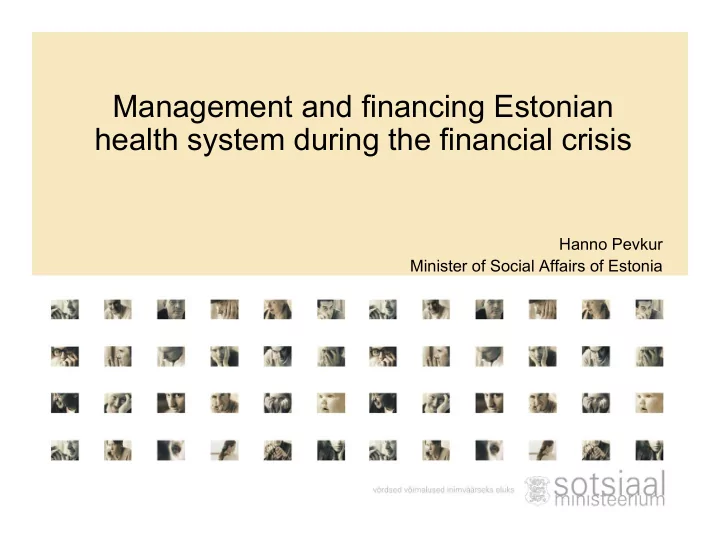

Management and financing Estonian health system during the financial crisis Hanno Pevkur Minister of Social Affairs of Estonia
Tallinn Charter: Health Systems for Health and Wealth Member States of WHO committed themselves to: Promote shared values of solidarity, equity and participation; Invest in health systems and foster investment across sectors; Promote transparency and be accountable; Make health systems more responsive; Engage stakeholders; Foster cross-country learning and cooperation; Ensure that health systems are prepared and able to respond to crises.
Be prepared Estonian Health Insurance Fund (EHIF) (1991) Accumulation of reserves in EHIF Primary health care based on family practitioners (1997) Family practitioner phone line 24/7 (2005) Hospital Master Plan (2002) National Health Development Institute to implement public health programmes (2003) Medical ambulance (since Soviet times) Use of WB loans, European structural funds and grants for capacity building, development of e-health system and renovation of hospitals
Decisions affecting health system made due to financial crisis – state budget cancelled compensation of capital costs from the state budget to EHIF increased general value added tax (VAT) (18% → 20%) increased value added tax on medicines (5% → 9%) increased contributions to unemployment insurance fund (0.9% → 1.5% → 4.2%) decreased funding for public health programmes, but also ambulance budget etc. 4
Social tax and EHIF expenditures, 2001 – 2012
Decisions affecting health system made due to financial crisis – EHIF due to high unemployment huge decline of payroll tax → reduction of health insurance revenues and budget increased maximally allowed waiting times (6 → 8 weeks for outpatients, 8 months remained for inpatient and day care) abolished dental care compensation to adults change of sick leave benefits system sharing more responsibilities with patients and employers, decrease of compensation (80% → 70%) coefficient 0.94 applied to EHIF price list starting Nov 15, 2009 (0.95 to specialist care and 0.97 to primary care since Jan 1, 2011), coefficient abolished since Jan 1, 2012 co-payment of 15% to nursing inpatient care starting 2010 6
Monitoring the impact of crisis
Priorities and measures to maintain health EHIF started to use accumulated reserves health budget was less affected than general state budget primary care and communicable diseases were prioritised within health budget rising of excise taxes for tobacco and alcohol (five times since 2008) alcohol excise will annually rise by 5% until 2016 state contributes to EHIF on behalf of unemployed state pays for emergency care of uninsured people 8
Improving efficiency and performance – health system level establishment of Health Board (merging 3 agencies) implementation of nationwide e-Health system Patient portal, e-ambulance, PACS, e-prescription ("Estonian digital prescription system - how does it work?„) use of structural funds for acute care hospitals infrastructure nursing care hospitals infrastructure public health use of funds from carbon quota trading to renovate hospitals to save energy use of Norway and Swiss grants 9
acute care hospitals infrastructure
nursing care hospitals infrastructure
Improving efficiency and performance – health system level - analysis Health System Performance Assessment Analysis of Financial sustainability of health financing (cooperation with WHO) Analysis of Financial sustainability of social insurance system
Improving efficiency and performance – health care services more priority to day care and ambulatory care school medicine is fully nurse-provided since 2010 more independency to midwives more responsibility and independency to family nurses strengthening of primary health care and its gatekeeping role – surveillance of chronical diseases changes in disability system (direct information change between GP-s and Social Insurance Board using E-health) etc. centralisation of management of primary health care to the Health Board revision of hospital master plan 13
Improving efficiency and performance - pharmaceuticals strengthening ingredient-based prescribing → doctors need to explain if they prescribe original drugs and pharmacies required to note if patients refuse cheaper alternatives e-prescription implemented Over 90% of all pharmaceuticals prescribed electronically! promotion of generic pharmaceutical use price agreements to 50% reimbursed drugs result: average co-payment per prescription 2009 – 36,9% 2010 – 36,2% 2011 – 34,5% Bill in Parliament – abolishing ceiling for 50% reimbursed drugs 14
Challenges – migration of health professionals motivate health personnel to work in Estonia and in remote areas scholarship to newly graduated specialist doctors starting to work in general hospital starting 2012 same under preparation for nurses changes in primary care – f.e. additional funds to family doctors based on the distance to the nearest hospital increased number of new doctors in residency training increased admission to medical school pilot training courses to activate physicians and nurses who left the health care system to come back and fulfil registration requirements deal with long term financial sustainability of the health system
Questions? Thank you!
Recommend
More recommend